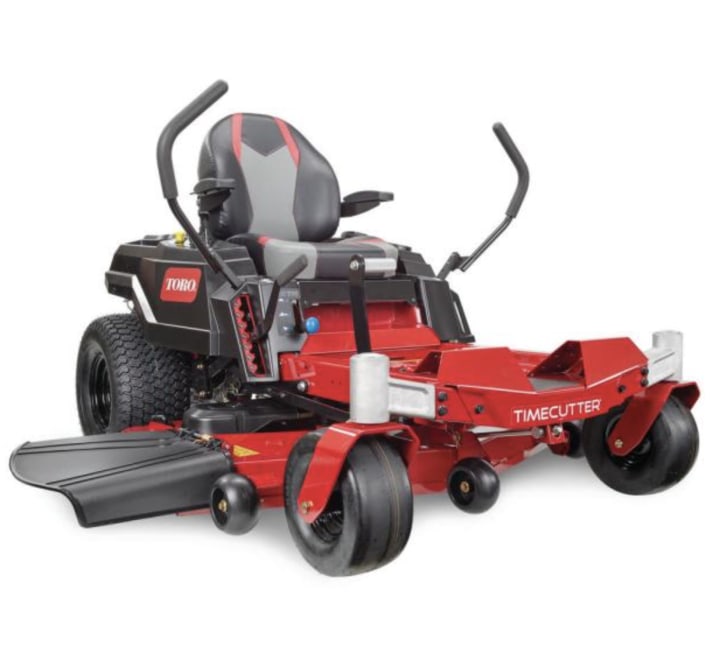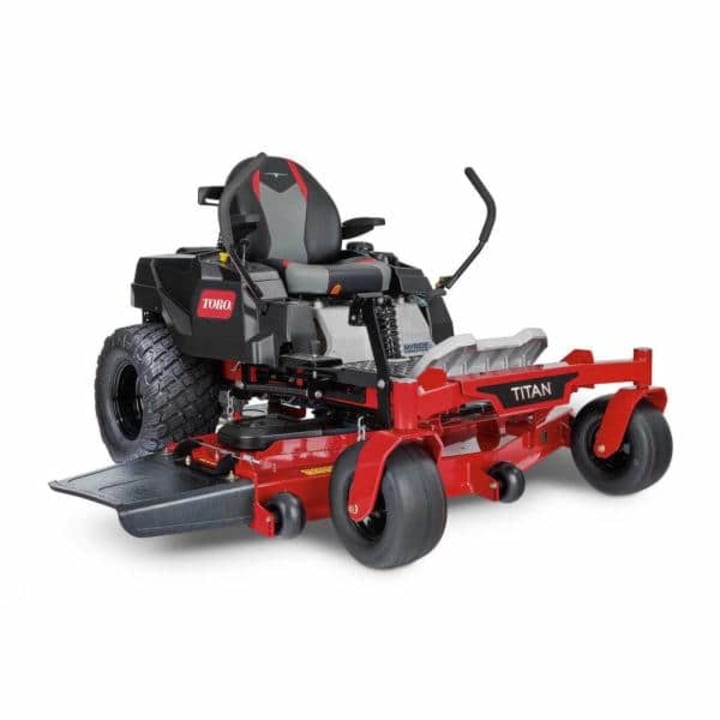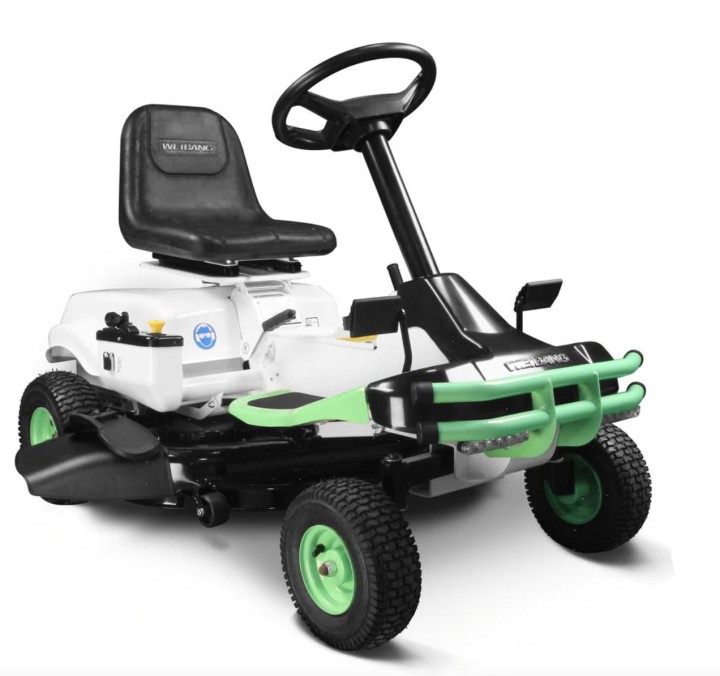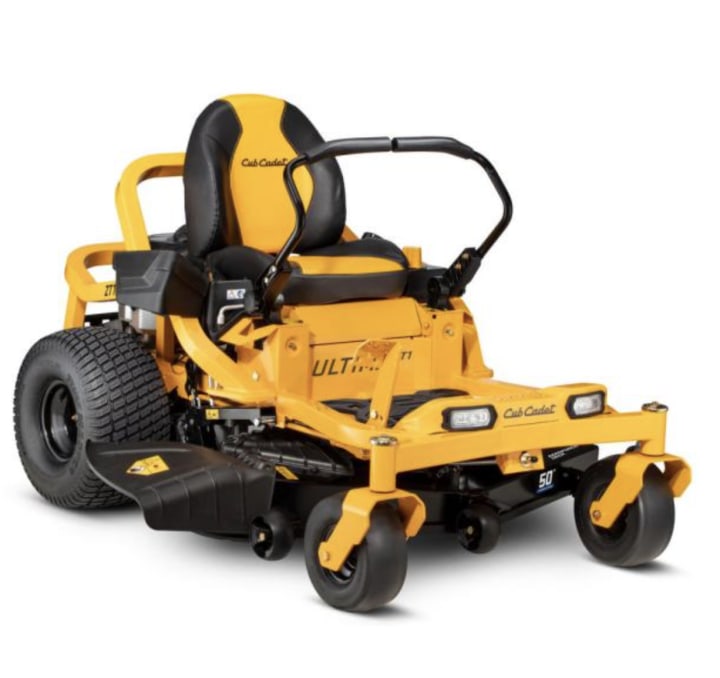A lawn mower can be a necessary home appliance for many homeowners, but those who have larger lawns to upkeep may find that self-propelled or push lawn mowers just don’t cut it. Experts recommend using riding lawn mowers for larger lawns since they have more powerful engines better equipped to efficiently handle bigger patches of grass. And as the name suggests, they’re designed so you can ride on top of them while you mow the lawn, which can come in handy when there’s a lot of land to tackle.
SKIP AHEAD Best riding lawn mowers | What to consider when shopping | Why trust Select?
“Unlike any other type of lawnmower, the riding ones let you just sit and steer instead of pushing a manually propelled type or walking behind a self-propelled type,” said Bryan McKenzie, a landscape designer and co-founder of Bumper Crop Times. “The riding type is much more cumbersome as it includes a larger motor and a full-sized seat, but it allows you to mow large areas significantly faster without any back fatigue — all you need is good sunscreen.”
A riding lawn mower is typically a major investment: The average cost is anywhere between $1,000 to upwards of $3,500, according to David Steckel, a home expert at Thumbtack. This means finding the right one can be crucial, especially with so many choices on the market. To help you get started, we consulted landscaping and gardening experts to explain the difference between a riding lawn mower and other types of mowers and what to look for when shopping for one, plus rounded up some highly rated ones that align with their guidance.
What are riding lawn mowers, exactly?
Riding lawn mowers are usually quicker and easier to use than push or self-propelled lawn mowers due to their large engines and wider mowing decks, which can cut a larger area of grass in one pass. The ability to ride the mower around can also be “crucial for homeowners who experience any back issues and can’t walk behind an average lawn mower without fatigue,” said McKenzie.
Experts said that shoppers with more than three-fourths of an acre of yard would benefit from a riding lawn mower since they can significantly cut down on mowing time. However, “if your yard is less than a half an acre, a riding lawn mower can make mowing your lawn more tedious than it needs to be because of the size of the machine in comparison to the yard,” said Steckel. At that point, it’s easier (and much cheaper) to use a push or self-propelled lawn mower — these types of mowers also turn the lawn mowing process into an opportunity for exercise and physical activity.
There are three main types of riding lawn mowers to consider: traditional lawn tractors, zero turning radius (ZTR) mowers and rear engine riding mowers.
Lawn tractors are gas-powered machines with a front mounted engine and a steering wheel for easy maneuvering — you simply sit on top and steer while the machine cuts the grass. “This is the most common and price-effective type of riding lawn mower,” said Steckel. They also usually have a wide turn radius, making them a good option for big lawns with slopes and hills.
ZTR mowers have a rear engine and feature a better turning radius than lawn tractors as well as higher maximum speeds. “They can turn on a dime and are usually faster and more precise than other riding mower options,” said Steckel. Instead of a steering wheel, these mowers typically have a pair of levers that control which way the machine turns, which McKenzie said can “offer a better front view” compared to mowers with a wheel (some newer models, however, feature the familiar wheel). According to Michael Hill, a garden and landscape expert at Garden Guidepost, this option is best “if you have a lawn that has sharp edges, architectural design or you need to get close to obstacles.”
Rear engine mowers have an engine in the back right below the seat. They’re more compact for easier storage and are usually more affordable than the other types of riding mowers, according to McKenzie. However, they tend to have smaller mowing decks (around 30 inches wide compared to at least 40 inches for other types of riding lawn mowers) and don’t tend to cut as well or as quickly as other riding mowers. “Typically if you have a lawn that is not huge but isn't small enough to use manual or push mowers, this is the best option,” said Hill.
Best riding lawn mowers to consider
To help you decide which riding lawn mower is best for you, we consulted experts on their recommended picks. We also narrowed down some highly rated options with varying cutting widths and power types for different size lawns and upkeep preferences. In general, experts recommended cutting widths of at least 30 inches for small yards under one acre, 36 inches for medium-sized yards (one to two acres), 42 inches for large yards (three to four acres) and 60 inches for even larger yards of five acres or more.
Best electric riding mower: RYOBI (out of stock)
RYOBI 38 in. 100 Ah Electric Rear Engine Riding Lawn Mower
This electric riding mower from RYOBI is a more eco-friendly alternative to gas-powered mowers and doesn’t require the tedious gas engine maintenance. It offers a 38-inch cutting width that can be efficient for medium-sized lawns, and it features a battery that RYOBI says has up to 2.5 hours of run time for cutting up to 2.5 acres of lawn per charge. This mower also equips LED headlights, a USB phone charger and cruise control features for added efficiency, according to the brand. However, it doesn’t have a zero turn radius, meaning it may be harder to maneuver around sharp edges or obstacles in your yard.
Best gas-powered riding mower: Toro
Toro 50 in. 23 HP TimeCutter Gas Dual Hydrostatic Zero Turn Riding Mower
This zero-turn mower has a large 50-inch cutting width and can be a good selection for yards up to four acres, according to the brand. It features Toro’s Smart Speed Technology, which the brand says lets you control your mowing speed in three modes: 4 mph in trim mode, 5.5 mph in tow mode and up to 7 mph while mowing. This mower also equips a built-in cup holder for drinks, shock-absorbing dampeners that make rides smoother and a step-through front end that makes it easier to get on and off of the mower while you pick up debris or move obstacles out of the way, the brand says.
Best affordable riding mower: Troy-Bilt
Troy-Bilt TB 30 in. Manual Drive Gas Rear Engine Riding Lawn Mower
If you’re looking for a more budget-friendly solution to maintain a smaller yard, this compact option from Troy-Bilt offers a 30-inch deck that’s enough for yards of one acre or less. Keep in mind this does have a manual transmission — which the brand calls Shift-on-the-Go transmission — that lets you choose between six speeds and adjust it accordingly using a lever.
Best riding mower for larger yards: Toro
Toro Titan 60 in. Gas Dual Hydrostatic Zero Turn Riding Mower
This zero-turn mower from Toro has the largest cutting width of all the options on this list at 60 inches wide, making it an efficient option for larger yards that are five acres and larger. The brand says this mower’s large cutting width can cover yards with obstacles up to seven acres, and its high maximum speed of 8.5 mph makes it the fastest option we recommend. For comfort, this mower features a high-back seat with armrests and foam-padded levers with hand grips.
Best riding mower for medium yards: Weibang
Weibang WB76E E-Rider 30in. 72V Electric Riding Mower
This electric riding mower from Weibang can be great for households with medium lawns, according to Ronnie Collins, a botanist and gardening blogger for Electro Gardening Tools. This mower features a 30-inch cutting width, an adjustable seat and a pair of maneuverable front wheels — and at 309 pounds, this is the lightest option on our list. “It’s more expensive than most commercial riding mowers with gas engines and broader cutting widths, but the benefits for households with limited storage space and [its] low-maintenance construction let it win easily,” Collins said.
Best riding mower for uphill yards: Cub Cadet
Cub Cadet Ultima ZT1 50 in. Zero Turn Riding Lawn Mower
This Cub Cadet riding lawn mower features a 50-inch-wide cutter, a steel frame and a 23H twin engine by Kawasaki. The mower is “best suited for uphill lawns thanks to the extra power from the engine and its lower height,” said Hill. It also features dual hydrostatic transmissions that let the mower accelerate up to 7.5 mph moving forward and up to 3.5 mph in reverse. Cub Cadet also makes an electric version of this model in case you're looking for the benefits of an electric unit.
What to consider when shopping for a riding lawn mower
Since riding lawn mowers can largely vary in size and function, it’s important to consider which features work best for your lawn before splurging.
Cutting width
As we reported in our guide to lawn mowers, the cutting width of a lawn mower measures the size of the strip the machine can cut in a single pass — the wider the cutting width is, the less time it’ll take to mow your lawn. Ideal cutting width varies from 30 inches to 42 inches for one acre of grass to at least 60 inches for five acres of grass, according to McKenzie. “You can actually get by perfectly well with 36 inches on up to two-acre lawns,” he added.
The width also correlates to the number of blades within the cutting deck: Smaller tractors can have one blade, while typical lawn tractors and ZTR mowers usually have two or three blades.
Though a wider cutting width can speed up the mowing process, McKenzie noted that it can also limit a machine’s mobility. He added that in some cases, “you’ll need an extra small self-propelled lawn mower to finish narrow spaces and slopes that are too steep for your glossy ride.”
Gas versus electric mowers
Many riding lawn mowers are gas-powered, meaning they require gasoline to operate. Others, meanwhile, are electric and use a battery-powered motor that needs to be charged. Though gas riding mowers are more durable and typically better suited for large lawns, Hill cautioned that they’re usually much louder than their electric counterparts and are less eco-friendly since they emit fumes.
Electric riding mowers can be cheaper and easier to maintain since they don’t require purchasing or changing out the engine oil, among other upkeep requirements. However, electric riding mowers do have their downfalls: Their functionality is limited to the amount of time they can be used in a single charge — if you have several acres of land (or simply forget to charge the battery), the power may not be enough to cut your entire lawn in one sitting.
Transmission type
The type of transmission on your riding lawn mower can determine the machine’s speed and dictate how it handles different backyard conditions, including mud and inclines. Manual transmission provides a set number of speeds — you select the one you want by using a lever and clutch. These are primarily found in older lawn tractors — similar to older cars — and can be useful for people who are accustomed to using a gear stick or can’t control speeds as easily with the pedal.
Hydrostatic transmission, also known as automatic transmission, is the default type for most riding lawn mowers and lets you shift gears automatically by pressing down on the pedal. This type tends to last longer — according to Mckenzie, it “requires the least maintenance and [has] the smoothest performance.”
Terrain and yard size
As experts noted, the size of your lawn will determine whether you should invest in a riding lawn mower — it’s usually not worth it for homeowners with less than half an acre. However, the type of terrain can also affect how the mower is used. A lawn tractor will work well on any relatively flat lawn and on landscapes with a lot of uneven sectors, especially if it features a steering wheel that provides more control. If you have a relatively flat yard with obstacles like rocks and gravel, “a ZTR will probably show better results as it can turn 360 degrees on a small spot and pivot at sharp angles,” McKenzie said.
Engine size
Your riding mower should also have an engine that matches the size of the yard, experts told us. Since lawn tractors are usually the largest type, they can provide “enough power to quickly treat two acres to five or more acres,” said McKenzie. For smaller areas, you can use a lightweight single-cylinder engine ZTR, which is usually more affordable. Two-cylinder engines — called V-twin engines — in ZTRs are more powerful than single-cylinder engines and provide less vibration, making them quieter and more comfortable. Riding mowers with V-twin engines are recommended “for large yards with two to five or more acres,” said McKenzie.
Why trust NBC Select?
NBC Select writer Mili Godio covers multiple topics spanning gardening and landscaping, from push lawn mowers to garden shears. For this story, Godio spoke to multiple lawn care and landscaping experts about how to shop for riding lawn mowers and why they can be useful for homeowners. Based on their guidance and recommendations, Godio reviewed the features of highly rated riding mowers from popular brands like Troy-Bilt, RYOBI, Toro and Husqvarna.
Catch up on NBC Select's in-depth coverage of personal finance, tech and tools, wellness and more, and follow us on Facebook, Instagram and Twitter to stay up to date.








